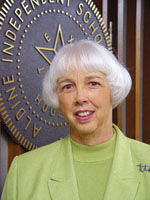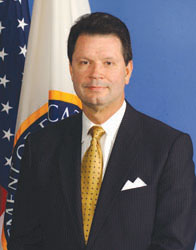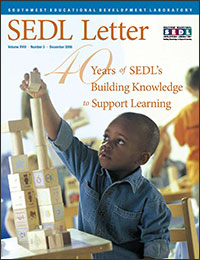Better Research, Better Schools: Making Today's Research Relevant to the Classroom
When students struggled in math, science, and reading in the Aldine Independent School District, Superintendent Nadine Kujawa mobilized her staff and armed them with education research to find solutions to low achievement.
“We kept looking at the research until we found something that was a good fit for our kids,” says Kujawa. “You can find research on almost any topic, but we examine what problem the research is addressing and ask whether that problem is the same as ours and go from there. The research is our guide.”

Nadine Kujawa, Aldine Independent School District
Kujawa’s emphasis on education research comes as no surprise to her staff. The district has been using research regularly to inform decisions related to instructional decisions and other decisions affecting how children learn—and excel—in the classroom.
“Whenever someone brings a proposed change to the table, we ask, ‘What does the research say?’” says Kujawa. “We send that message to principals in every building. I am a firm believer in education research and the past pointing the way to the future.”
Kujawa’s efforts are not going unnoticed. This year, she was named regional Superintendent of the Year for her visionary leadership by the Texas Association of School Administrators and Texas Association of School Boards.
The Houston-area school district is seeing results, which Kujawa attributes in large part to research and data-driven decision making. The district was the winner of the Texas Award for Performance Excellence last year. “Ten years ago, we were ranked 53 out of 54 school districts,” says Kujawa. “Now we rank at the state average or higher.”
The increase in ranking is significant because the district serves a substantial high-poverty and minority-student population. Kujawa says her district has been recognized by two leading Texas universities as one of the top five districts of its size that best educate economically disadvantaged minority students.
Education research is not without its barriers, though. “The biggest one is the amount of research out there, locating what you need, and having the time and the staff to actually use the research effectively,” says Kujawa.
Kujawa regularly brings in experts to work with teams across the district to critically review research, discuss findings in detail, and think more deeply about how to apply those findings to the district’s challenges and students’ needs.
Administrators and teachers also have access to research tools, information related to effective school practices, and data. Kujawa says the focus on education research has led to positive changes for the Aldine Independent School District. “Sometimes research forces us to make really difficult decisions. As researcher Ron Edmonds puts it, ‘We know what to do. The research tells us what to do. The question is, do we have the courage to do it?’”
In today’s high-stakes environment, public schools have little choice but to improve. The standards and accountability movement in the early 1990s and the No Child Left Behind Act (NCLB) have focused national attention on school improvement and heightened the need for high-quality education research.
Public schools also are operating in a highly competitive environment, as savvier parents shop for schools for their children. Academic achievement is often one of the top factors in a parent’s decision about where to send his or her child to school. Finding answers to what works and identifying promising innovations can make or break a school’s success.
Is Today’s Education Research Keeping Up With Schools’ Needs? The Challenges
Traditionally, the federal government has served as the largest provider of education research and has increased its efforts to encourage practitioners to use and apply research as an integral part of decisions about policy and practice.
NCLB also requires schools to use “scientifically based” programs and practices in areas such as reading instruction and professional development. Leading government, policy, and research organizations also are looking at how to connect education research to practice so the research is more useful and relevant to practitioners like Kujawa.
Still, challenges remain. “There are many circumstances where we can’t get them what works because the knowledge base is not there,” says Grover J. “Russ” Whitehurst, the director of the Institute of Education Sciences (IES), the research arm of the U.S. Department of Education. “Growing the knowledge base is critical, and we are doing that as we increase our number of grants for research.”
The number of research grants awarded by IES has risen from 15 a year under the now-defunct Office of Education Research and Improvement (OERI) to 65 a year since the institute replaced OERI in 2002, says Whitehurst.
Some say that’s a good start, but it’s not enough to keep up with the demand for high-quality education research, especially at a time when schools are in greater need than ever before of innovations to improve student achievement.
While he applauds the institute’s efforts to improve education research, Jim Kohlmoos, who heads the National Education Knowledge Industry Association (NEKIA), says funding for education research is “totally inadequate.”
“When you compare the federal investment in education research to other federal sectors, education research is among the lowest investment of them all,” says Kohlmoos. “When the Department of Defense creates a new weapon, there is a big, upfront investment. The federal government is a venture capitalist in the beginning. It’s not the same way in education, and it should be.”
In 2002, the What Works Clearinghouse was created under the Institute for Education Sciences to provide a credible source of research focusing on effective practices in education. While the intent of the What Works Clearinghouse draws high marks, some raise concern that the federal government’s emphasis on what works is neglecting research on innovative strategies for instruction, learning, and professional development.
“The federal government has done a good job but has left some pieces unattended,” says Wes Hoover, president and CEO of the Southwest Educational Development Laboratory (SEDL). “Developing new practices or testing strategies that are innovative—there’s just not enough money to do all of those things.”
Another challenge noted by those interviewed for this article, including Whitehurst, is that too many education leaders and teachers are not adequately trained in a setting that makes them think about research as a critical component of their work. “People look for advice from other professionals or attend a conference or look at a slick brochure without paying closer attention to the evidence,” says Whitehurst.
Observers also say more must be done in colleges of education to prepare teachers and school leaders to better use research in their everyday work. Whitehurst recalls a meeting with deans of colleges of education whom he says collectively train 90% of the teachers in the United States. He asked them how many require a research methods course as part of their degree. “Two people raised their hands,” says Whitehurst. “It’s changing, though.”
Efforts to Improve Education Research
For his part, Whitehurst has implemented what have been described as ”sweeping” changes in the last 4 years since he was charged with leading the Institute of Education Sciences. A major goal is to build the knowledge base that he and others believe is lacking. “One can’t expect either the states, districts, or private sector to carry the burden of new knowledge or interventions,” says Whitehurst.

Grover J. “Russ” Whitehurst,
head of the Institute for
Education Sciences
The institute operates with a higher degree of political independence than its predecessor with the director now serving a 6-year term, which is designed to cover more than one presidential term. Whitehurst says the staff has been beefed up with the hiring of 50 people, and a lot of programs that weren’t research-related have been moved out altogether so that greater emphasis is placed on the institute’s mission.
Whitehurst also is creating a new crop of PhD-level scientists who are trained and qualified to contribute to the field of education science by conducting rigorous evaluations, developing new products and approaches grounded in science, and designing valid tests and measures. The Institute of Education Sciences has developed predoctoral and postdoctoral fellowship programs in partnership with universities across the United States.
More than 150 students are expected to graduate at the PhD level from participating universities, including Vanderbilt, Florida State, Carnegie Mellon, the University of Chicago, and Northwestern. Successful predoctoral fellows receive a Certificate in Education Sciences in addition to a doctorate in their discipline.
The federal government is not the only agency focused on improvements. National research and policy advocacy organizations such as NEKIA are looking at ways they can contribute to higher-quality education research.
NEKIA, for example, has developed a concept called “communities of knowledge.” The goal is to make a stronger connection in the field between educators and researchers with the help of a facilitator. Groups of educators sit down with researchers to examine problems in the classroom. Together, they tap both their day-to-day experience in the classroom and their expertise in research to solve those challenges.
Kohlmoos says keeping researchers isolated from practitioners increases the odds that their research won’t have any relevance or usefulness to solving real-world problems faced by teachers, principals, or superintendents.
“Everyone says it’s important to have high-quality, rigorous research to improve schools, but very few talk about the issue of use of research,” says Kohlmoos. “It’s one thing to have motivation to improve schools or to have great research—but what connects both? That has been a policy focus of ours.”
As the reauthorization of NCLB gets underway next year, NEKIA will advocate for policy changes that place just as much emphasis on “relevant and useable research” as has been placed on scientifically based research.
Strategies at the State Level
Some state education agencies, such as the Alabama State Department of Education, also are stepping up their efforts to provide school leaders and educators with the tools they need to be better-informed consumers of research.

Ruth Ash, Alabama State
Department of Education
The state department launched the Alabama Leadership Academy to increase the achievement of all students in the state by supporting the growth and development of teachers, principals, and superintendents as leaders of instruction. Key to this work is deepening their understanding and use of education research in areas of instruction, learning, and other policy and practice areas that affect student learning.
The emphasis on education research also played a major role in setting the state’s direction for reading. In the late 1990s, Alabama faced two camps of thinking on how students should learn to read: phonics and whole language. The opposing sides were convened to review in detail what education research said about how students best learn to read.
“We told them, ‘We are going to look at what all the education research says and we want you all to agree that whatever the research says, we’re going to do it,’” recalls Ruth Ash, deputy superintendent with the Alabama State Department of Education. “We now have a research-based reading program in every school with grades 1–3.”
This year, the legislature funded the Alabama Reading Initiative at $56 million, according to Ash. The initiative’s goal is to significantly improve reading instruction and ultimately achieve 100% literacy among public school students.
Alabama state education leaders took the same approach with the Alabama Math, Science, and Technology Initiative (AMSTI) by looking first at what research said about effective practices in teaching students math and science.
AMSTI is the Alabama State Department of Education’s initiative to improve math and science teaching statewide. Students in AMSTI schools learn math, science, and technology through activity-based, inquiry approaches consistent with the latest research on effective math and science instruction.
“In every participating school, 85% of teachers have to abide by the research and what it says works,” says Ash. “The principal leads the effort and agrees to an outside evaluator to see if it really does improve student achievement. Not only do we use research, but we are contributing to it.”
The result, according to the initiative’s Web site: “AMSTI schools showed consistently and often statistically significant gains over non-AMSTI schools in all areas tested by the Stanford 10 and by the Alabama Reading and Mathematics Test in both elementary and middle school grades.”
“It has helped educators see that they need to use research to inform how to make decisions about learning,” says Ash.
Connecting Education Research to the Classroom
Building a strong base of high-quality and relevant research to help teachers, principals, superintendents, and school board members is a critical first step.
Using the research findings to develop practical and useful tools, services, and products to help practitioners and policymakers apply the research at the local level has been the focus of organizations such as SEDL. The organization is helping district and school leaders fit the pieces of the research puzzle together in ways that reap results for students and teachers.
“You have to have people who can connect those tools and services to people in the field by helping them use the tools, reflect on their practices, and modify strategies along the way,” says SEDL’s Wes Hoover. “We see that as our niche: connecting research and practice through building knowledge and tools and engaging educators in their use.” For example, services such as coaching teachers provide a safe environment for educators to change practice and to see whether those changes are having the effect they had hoped.
Hoover also is well-versed in the frustrations voiced by practitioners about the lack of high-quality research germane to their work. To fill the gaps, SEDL helps educators understand the different “levels” of research, the confidence they can have in it given the research methods used, and how what currently exists might apply to their individual needs or challenges.
“There are things you can and cannot do with research, and practitioners need to be aware of that,” says Hoover. “It’s very rare that a school can take a piece of research and implement it in the way it was in the research studies. Adaptation presents real challenges.”
As educators and policymakers across the country strive to improve learning, instruction, and achievement, efforts to improve education research at the federal level and among policy and research organizations could not be more timely. The question is whether those efforts will be timely enough to address the challenges in today’s public schools.
Lesley Dahlkemper is the president of Denver-based Schoolhouse Communications (http://www.schoolhousecom.com), a firm specializing in strategic communications, public engagement, and editorial services in the K–16 arena.
Next Article: SEDL Celebrates Its History and the ESEA

